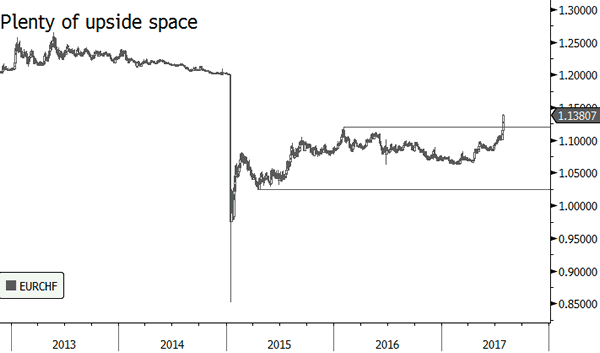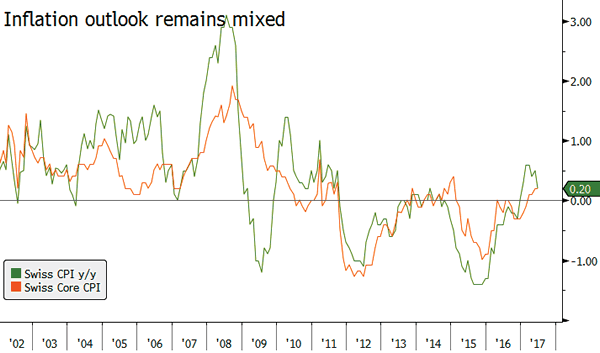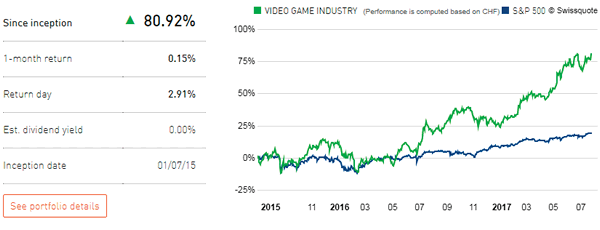- What’s Driving CHF Weakness – Peter Rosenstreich
- The Future Of Bitcoin – Buy Fear, Sell Greed – Yann Quelenn
- USD In The Doldrums. Will It Last? – Arnaud Masset
- Video Game Industry
Economics – What’s Driving CHF Weakness?
The aggressive move higher in EURCHF has FX traders buzzing. Despite rumours of M&A flows and mixed Swiss economic data there was really no fundamentals event trigger driving the move. While the timing is headscratching the mounting headwinds was eventually going to catch up with the CHF. Placing the blame on SNB Jordon calling the CHF overvalued would be completely off base as he and other Swiss central banker have held the "overvalued" corporate for years. The Swiss economic outlook remains cloudy while Europe continues to improve. Monetary policy shift have been the defining driver for FX price in the last 10 years. Weak inflation forecast will keep the SNB accommodative while the ECB is clearly shifting toward "normalization." There has been a clear trend for G10 central banks to consider balance sheet consolidation (primary driver of recent FX moves), at the same time the SNB remains focused on balance sheet expansion. This monetary policy strategy divergence makes selling CHF an obvious trade. The SNB remains dedicated to balance sheet expansion, as long as they don’t get hurt.
In addition as political uncertainty in Europe has all but disappears the primary driver of risk aversion CHF inflows have diminished. The negative carry of the CHF will make holding the franc a difficult position to justify. The CHF remains the most overvalued G10 currency regardless of what model you chose indicated that further depreciation is likely. In addition, the SNB stand ready to either support further weakness by actually intervention or just spread rumors of activity. We have received countless questions this week inquiring if the SNB was in the markets (we dont think so but only site deposits will prove antidotal evidence). With the "normalizations" theme retrenching, global economic cycle expanding and the SNB expected to hold accommodating policy for some time,.


Cryptocurrencies – The Future Of Bitcoin – Buy Fear, Sell Greed
The 1st of August is a key date for Bitcoin. Indeed there is a material risk that the most famous cryptocurrency could be split into two different digital currencies. A new algorithm needs only to be activated and simply validated by a majority of miners, the people who approve transactions, for bitcoin to be broken in half.
The Bitcoin network’s transactions is only able to process less than 7 transactions per second, which in this nanosecond algo-trading world, would prevent its expanded use. In order to increase the settlement speed, a new transaction process, must be implemented. If users do not accepted this change, the split will occur. Then there would be then two different bitcoins (names have not been assigned) for which owners would need to choose which one they want.
However, it seems that a small community of Bitcoins users is trying to organize a hard fork from Bitcoin to a new protocol called "Bitcoin Cash". For the time being, it is going to be a minor change. But this change may have deep consequences if other users decide to switch towards this new "altcoin" cryptocurrency.
There may be one thing to take care of there. Indeed, surprises may still happen and the new version can still be successful in the future. Yet in case of a now very likely hard fork scenario – The Bitcoin Cash creation -, the thing to do should be to leave your own bitcoin in a wallet and waiting to see which exchanges support both versions. Investors will anyway own bitcoin on both forks. On the contrary Bitcoin stored at exchanges depend on the fact that the marketplace may not fully support both assets.
Cryptocurrencies The Future Of Bitcoin – Buy Fear, Sell Greed Yet while certainly intriguing, the story is not new. Last year, the cryptocurrency Ethereum had to be split after a hack and it would have been wise to keep its Ether in a wallet. Delaying the decision, would have allowed the holder to choose the ETH version which had been up to almost $400 while the classic version ETC is stalling below $23.
Regarding the market, volatility in all cryptocurrencies have been massive on normal days. Bitcoin fork fears are definitely driving the whole crypto market at the moment. Earlier last week, the bitcoin reached again almost $3000 before bouncing lower. This has consequences as all other coins prices are also suffering at the moment. This may be a good moment to stack a few more altcoins.
Bitcoin’s future looks definitely unclear at the moment and despite its innovative technology, the oldest cryptocurrency does not compete anymore with newcomers (altcoins). Bitcoin’s first mover quality provides it with a strategic advantage for potential massive usage. However, in this new virtual reality it is not always the best technology that wins, it is the best experience.
Economics – USD In The Doldrums. Will It Last?
Dovish statement
Last week was another week to forget for the greenback as the USD extended losses against most of its peers amid dovish FOMC statement and lacklustre economic data. As broadly expected, FOMC members decided to leave monetary policy unchanged, maintaining the target range for the federal funds rate to 1% to 1.25% and not providing a clear timing about its balance sheet reduction plan. Little changes were made to the statement compared to the June version. The Federal Reserve acknowledged that inflation measures have declined and are now running below the 2% target. However minor – but meaningful – changes were made regarding the expected starting date of the balance sheet normalization program. The June statement says the Fed expects the program to be launched this year, while in the latest version it writes it should be implemented "relatively soon".
From our standpoint, we think this is definitely a dovish change as it removes clarity regarding the timing, giving more room to the Fed regarding the starting date of the balance sheet run off. Given the recent disappointing economic data, the Fed wants the greatest flexibility possible should this negative trend persist.
Lacklustre data
The latest batch of data were rather disappointing and were of bad omen for the future. Durable goods orders printed well above median forecast suggesting a solid recovery in June after two months of contraction. The headline gauge increased 6.5%m/m versus 3.9% expected and an upwardly revised figure of -0.1% in May. The upside surprise was essentially due to a sharp bounce in new orders for aircraft, thanks to the Paris Air Show (23-25 June). Excluding the volatile transportation components, core durable goods orders came in below estimates, printing at 0.2%m/m versus 0.4% expected and 0.6% previous reading.
Overall, the report suggests that the manufacturing activity continues to expand at a moderate pace, while the anaemic demand for consumer goods such as vehicles and electronic products signals households’ consumption is not ready to take of yet, which is of bad omen for inflation.
On the growth side, second quarter GDP figures failed to impress. According to preliminary estimates, the US economy grew 2.6%q/q annualised in Q2 versus 2.7% expected. First quarter figures was downwardly revised to 1.2% from 1.4%. Finally, the core PCE gauge surprised slightly to the upside, printing at 0.9%q/q annualised versus 0.7% expected. However, previous quarter reading was downwardly revised to 1.8% from 2.0%. Let’s just call it square then.
Investors have a real need to see some solid and uninterrupted flow of encouraging data from the US. This only under these conditions that we’ll see a bounce back of the US dollar and the pursuit of recovery in US yields. On a side note, we think the USD sell-off is complete and that further weakness is unlikely. Investors will be eager to jump back in long USD position as soon as data improves slightly.
Themes Trading – Video Game Industry
Much ground has been covered since the first video game consoles of the early 70s, which offered only 2D games in black and white and with no sound. Since then, the video game industry has been growing exponentially as computer technology has advanced. Nowadays, blockbuster video games enjoy massive budgets, easily surpassing those of Hollywood movies: budgets in excess of $100 million are not uncommon. According to the ESAF, computer and video game sales in the US alone reached $15.4 billion in 2014, more than double the 2007 figure of $7.3 billion. However, the fastest growth is coming from social network gaming, mobile apps and online gaming, which represent more than 65% of the total revenue.
The video game industry is evolving faster than any other, constantly adapting to the latest technological breakthrough. The industry has already embarked on its latest mutation. However, it’s not too late to be a part of it. We built this theme with the aim of offering exposure to the whole video game market, from traditional physical media distribution and console builders to new market entrants. We have overweighted the fast-growing part of the industry, meaning companies active in digital distribution, mobile app development and online gaming-related companies.














